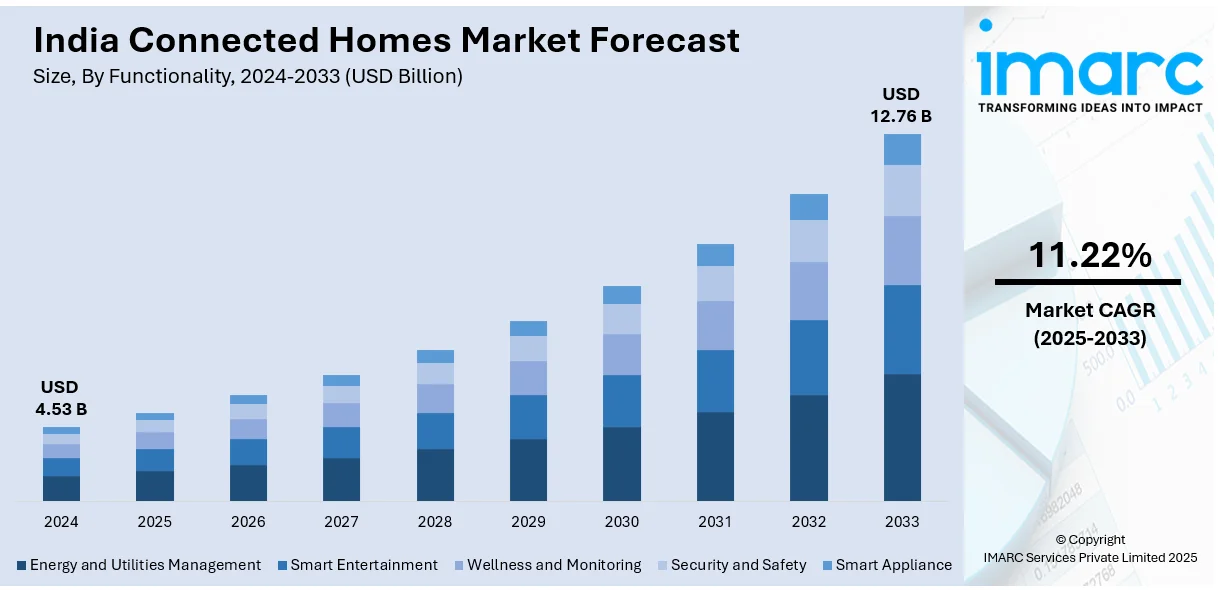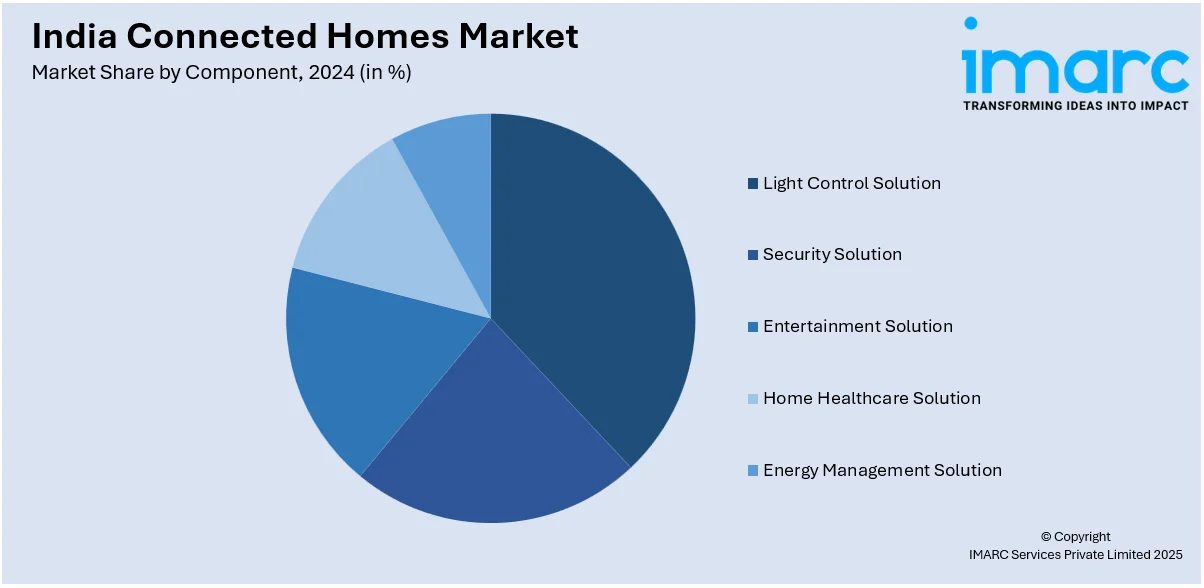
India Connected Homes Market Size, Share, Trends and Forecast by Functionality, Component, Platform, and Region, 2025-2033
India Connected Homes Market Overview:
The India connected homes market size reached USD 4.53 Billion in 2024. Looking forward, IMARC Group expects the market to reach USD 12.76 Billion by 2033, exhibiting a growth rate (CAGR) of 11.22% during 2025-2033. The market is growing due to increasing internet penetration, rising disposable incomes, expanding smart city initiatives, growing consumer awareness, widespread adoption of artificial intelligence (AI) and Internet of Things (IoT), increasing demand for energy efficiency, and the expansion of home automation solutions across urban and semi-urban areas.
|
Report Attribute
|
Key Statistics
|
|---|---|
|
Base Year
|
2024 |
|
Forecast Years
|
2025-2033
|
|
Historical Years
|
2019-2024
|
| Market Size in 2024 | USD 4.53 Billion |
| Market Forecast in 2033 | USD 12.76 Billion |
| Market Growth Rate 2025-2033 | 11.22% |
India Connected Homes Market Trends:
Growing Adoption of AI and IoT in Smart Homes
The integration of AI and the IoT is transforming the India connected homes market outlook. In line with this, the market for urban buyers is shifting toward devices under voice command, AI-powered cameras, and smart lighting options. Moreover, connected home technology through IoT creates simple automatic device connections that boost household efficiency as well as protection mechanisms and simplify daily operations. These technologies experience increased adoption because of expanding 5G and broadband network technologies. For instance, in March 2025, Elon Musk's Starlink partnered with India's leading telecom operators, Reliance Jio and Bharti Airtel, to bring satellite internet services to remote parts of India, enhancing the infrastructure for IoT-enabled smart homes. Besides this, the adoption of AI-based predictive maintenance for home appliances continues to rise which reduces operational costs and gives users better experiences. Furthermore, businesses adopt AI-based home ecosystem platforms for users while consumers want automated personalized homes because they choose these systems to match individual needs. The implementation of AI and IoT-based home automation solutions also receives support from government policies focused on digitalization and smart cities which reduces the cost of smart living solutions, thus making them accessible to wider groups of people.

To get more information on this market, Request Sample
Rising Demand for Energy-Efficient and Sustainable Smart Homes
The rising demand for energy efficiency and sustainability is driving the India connected homes market growth. In addition to this, Indian homeowners have started adopting smart energy management systems that contain automated lighting along with intelligent thermostats and energy-monitoring solutions as they are focused on reducing electricity expenses and environmental impact. Concurrently, modern home technology that works with solar power systems is becoming increasingly popular because it supports the renewable energy (RE) initiatives of the country. For example, in February 2024, Finance Minister Nirmala Sitharaman announced a rooftop solarization initiative aiming to provide up to 300 units of free electricity monthly to one crore households, promoting the adoption of solar energy in residential sectors. In confluence with this, the Indian government emphasis on enforcing environmental policies related to green buildings as energy conservation measures creates momentum for sustainable home automation adoption. Moreover, people are becoming more interested in smart home appliances that maximize energy usage since energy-efficient air conditioners, refrigerators, and water heaters now track power use in real time. Apart from this, smart meters coupled with home energy management systems allow homeowners to base their reduction of carbon emissions on data they track for their homes. As a result, companies release eco-friendly smart home solutions that target environmentally conscious customers because sustainability elements have become essential buying factors, thereby boosting the India connected homes market share.
India Connected Homes Market Segmentation:
IMARC Group provides an analysis of the key trends in each segment of the market, along with forecasts at the region level for 2025-2033. Our report has categorized the market based on functionality, component, and platform.
Functionality Insights:
- Energy and Utilities Management
- Smart Entertainment
- Wellness and Monitoring
- Security and Safety
- Smart Appliance
The report has provided a detailed breakup and analysis of the market based on the functionality. This includes energy and utilities management, smart entertainment, wellness and monitoring, security and safety, and smart appliance.
Component Insights:

- Light Control Solution
- Security Solution
- Entertainment Solution
- Home Healthcare Solution
- Energy Management Solution
A detailed breakup and analysis of the market based on the component have also been provided in the report. This includes light control solution, security solution, entertainment solution, home healthcare solution, and energy management solution.
Platform Insights:
- Smartphones
- Laptops
- Home Gateway
- Others
The report has provided a detailed breakup and analysis of the market based on the platform. This includes smartphones, laptops, home gateway, and others.
Regional Insights:
- North India
- South India
- East India
- West India
The report has also provided a comprehensive analysis of all the major regional markets, which include North, South, East and West India.
Competitive Landscape:
The market research report has also provided a comprehensive analysis of the competitive landscape. Competitive analysis such as market structure, key player positioning, top winning strategies, competitive dashboard, and company evaluation quadrant has been covered in the report. Also, detailed profiles of all major companies have been provided.
India Connected Homes Market News:
- In May 2024, D-Link completed the first phase of 'CONNEXION 2024,' engaging with over 350 enterprise partners and system integrators across eight Indian cities, fostering collaborations to drive digital connectivity solutions in the smart home sector.
- In May 2024, Godrej Security Solutions introduced the 'See Thru Pro Nova,' at the Smart Home Expo 2024 in Mumbai. It is an advanced video door phone with integrated Wi-Fi and smartphone app connectivity, enhancing home security and convenience.
India Connected Homes Market Report Coverage:
| Report Features | Details |
|---|---|
| Base Year of the Analysis | 2024 |
| Historical Period | 2019-2024 |
| Forecast Period | 2025-2033 |
| Units | Billion USD |
| Scope of the Report |
Exploration of Historical Trends and Market Outlook, Industry Catalysts and Challenges, Segment-Wise Historical and Future Market Assessment:
|
| Functionalities Covered | Energy, Utilities Management, Smart Entertainment, Wellness, Monitoring, Security, Safety, Smart Appliance |
| Components Covered | Light Control Solution, Security Solution, Entertainment Solution, Home Healthcare Solution, Energy Management Solution |
| Platforms Covered | Smartphones, Laptops, Home Gateway, Others |
| Regions Covered | North India, South India, East India, West India |
| Customization Scope | 10% Free Customization |
| Post-Sale Analyst Support | 10-12 Weeks |
| Delivery Format | PDF and Excel through Email (We can also provide the editable version of the report in PPT/Word format on special request) |
Key Benefits for Stakeholders:
- IMARC’s industry report offers a comprehensive quantitative analysis of various market segments, historical and current market trends, market forecasts, and dynamics of the India connected homes market from 2019-2033.
- The research report provides the latest information on the market drivers, challenges, and opportunities in the India connected homes market.
- Porter's five forces analysis assist stakeholders in assessing the impact of new entrants, competitive rivalry, supplier power, buyer power, and the threat of substitution. It helps stakeholders to analyze the level of competition within the India connected homes industry and its attractiveness.
- Competitive landscape allows stakeholders to understand their competitive environment and provides an insight into the current positions of key players in the market.
Key Questions Answered in This Report
The market in the region was valued at USD 4.53 Billion in 2024.
The India connected homes market is projected to exhibit a CAGR of 11.22% during 2025-2033, reaching a value of USD 12.76 Billion by 2033.
The key drivers include increasing internet penetration, rising disposable incomes, expanding smart city initiatives, and growing consumer awareness. The widespread adoption of AI and IoT, demand for energy efficiency, and the expansion of home automation solutions across urban and semi-urban areas also contribute significantly to market growth.
Need more help?
- Speak to our experienced analysts for insights on the current market scenarios.
- Include additional segments and countries to customize the report as per your requirement.
- Gain an unparalleled competitive advantage in your domain by understanding how to utilize the report and positively impacting your operations and revenue.
- For further assistance, please connect with our analysts.
 Request Customization
Request Customization
 Speak to an Analyst
Speak to an Analyst
 Request Brochure
Request Brochure
 Inquire Before Buying
Inquire Before Buying




.webp)




.webp)












